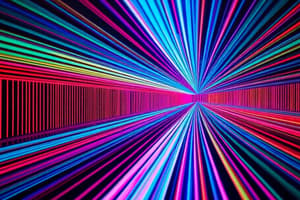Podcast
Questions and Answers
What is the wavelength of light emitted by the common He-Ne laser?
What is the wavelength of light emitted by the common He-Ne laser?
- 1064 nm
- 633 nm (correct)
- 780 nm
- 532 nm
What is the maximum value that sin θ can have?
What is the maximum value that sin θ can have?
- 1 (correct)
- 1.5
- 0.5
- 2
What is the equation that describes constructive interference?
What is the equation that describes constructive interference?
- d sin θ = mλ (correct)
- d cos θ = mλ
- d tan θ = mλ
- d sec θ = mλ
What is the highest-order constructive interference possible with the given system?
What is the highest-order constructive interference possible with the given system?
What is the relationship between the angle for constructive interference and the wavelength?
What is the relationship between the angle for constructive interference and the wavelength?
What is the purpose of using interference patterns?
What is the purpose of using interference patterns?
What is the value of m that corresponds to the maximum diffraction angle?
What is the value of m that corresponds to the maximum diffraction angle?
What is the condition for constructive interference?
What is the condition for constructive interference?
What is the reason why interference patterns do not have an infinite number of lines?
What is the reason why interference patterns do not have an infinite number of lines?
What is the relationship between the number of fringes and the wavelength?
What is the relationship between the number of fringes and the wavelength?
Flashcards are hidden until you start studying
Study Notes
Young's Double Slit Experiment
- In 1801, Thomas Young performed the double slit experiment, which showed that light is a wave.
- Young's experiment involved passing pure-wavelength light through a pair of vertical slits, creating a pattern of numerous vertical lines spread out horizontally on a screen.
- The acceptance of the wave character of light came as a result of Young's experiment.
- The wave character of light is not ordinarily observed due to the need for light to interact with something small, such as closely spaced slits, to show pronounced wave effects.
- Young first passed light from a single source through a single slit to make the light coherent (in phase or having a definite phase relationship).
- Then, he passed the light through a double slit, providing two coherent light sources that interfered constructively or destructively.
Interference Patterns
- Constructive interference occurs when identical waves are in phase, resulting in bright lines on the screen.
- Destructive interference occurs when identical waves are exactly out of phase or shifted by half a wavelength, resulting in dark regions on the screen.
- The light must fall on a screen and be scattered into our eyes for us to see the pattern.
- The angles at which constructive and destructive interference occur depend on the wavelength and the distance between the slits.
Path Length Difference and Interference
- The path length difference between the two waves from the slits to a common point on the screen is given by d sin θ, where d is the distance between the slits and θ is the angle from the original direction of the beam.
- For constructive interference, the path length difference must be an integral multiple of the wavelength, or d sin θ = mλ, for m = 0, 1, −1, 2, −2,...
- For destructive interference, the path length difference must be a half-integral multiple of the wavelength, or d sin θ = (m+1/2)λ, for m = 0, 1, −1, 2, −2,...
- The order of the interference is given by m.
Double Slit Interference Pattern
- The intensity of the bright fringes falls off on either side, being brightest at the center.
- The closer the slits are, the more the bright fringes spread out.
- Small d gives large θ, hence a large wave effect.
Applications of Double Slit Interference
- Interference patterns can be used to measure wavelengths.
- The technique is still widely used to measure electromagnetic spectra.
- For a given order, the angle for constructive interference increases with λ, so that spectra can be obtained.
Studying That Suits You
Use AI to generate personalized quizzes and flashcards to suit your learning preferences.




